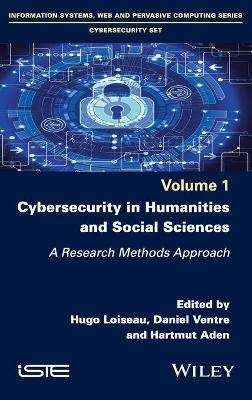
Cybersecurity in Humanities and Social Sciences
ISTE Ltd and John Wiley & Sons Inc (Verlag)
978-1-78630-539-8 (ISBN)
Hugo LOISEAU, École de politique appliquée Faculté des lettres et sciences humaines Université de Sherbrooke Quebec Canada. Daniel VENTRE, CESDIP Laboratory CNRS Guyancourt France. Hartmut ADEN, Berlin School of Economics and Law Berlin Institute for Safety and Security Research Germany.
Introduction ix
Daniel VENTRE, Hugo LOISEAU and Hartmut ADEN
Chapter 1 The “Science” of Cybersecurity in the Human and Social Sciences: Issues and Reflections 1
Hugo LOISEAU
1.1 Introduction 1
1.2 A method? 4
1.3 Data? 11
1.4 One or more definition(s)? 16
1.5 Conclusion 20
1.6 References 21
Chapter 2 Definitions, Typologies, Taxonomies and Ontologies of Cybersecurity 25
Daniel VENTRE
2.1 Introduction 25
2.2 Definition 27
2.2.1 What is a definition? 27
2.2.2 Usefulness of definitions 29
2.2.3 Rules for constructing definitions 29
2.2.4 Definitions of cybersecurity 32
2.3 Typology 43
2.3.1 What is a typology? 44
2.3.2 Usefulness of typologies 44
2.3.3 Rules for the construction of typologies 45
2.3.4 Cybersecurity typologies 46
2.4 Taxonomy 48
2.4.1 What is a taxonomy? 48
2.4.2 Usefulness of taxonomy 49
2.4.3 Rules for the construction of taxonomies 49
2.4.4 Taxonomies of cybersecurity 50
2.5 Ontologies 51
2.5.1 What is ontology? 52
2.5.2 Usefulness of ontologies 53
2.5.3 Rules for construction of ontologies 53
2.5.4 Cybersecurity ontologies 54
2.6 Conclusion 56
2.7 References 57
Chapter 3 Cybersecurity and Data Protection – Research Strategies and Limitations in a Legal and Public Policy Perspective 67
Hartmut ADEN
3.1 Introduction 67
3.2 Studying the complex relationship between cybersecurity and data protection: endangering privacy by combating cybercrime? 68
3.2.1 Potential tensions between cybersecurity and data protection 69
3.2.2 Potential synergies between cybersecurity and data protection 72
3.3 Methodological approaches and challenges for the study of cybersecurity – legal and public policy perspectives 74
3.3.1 Legal interpretation and comparison as methodological approaches to the study of cybersecurity 74
3.3.2 Public policy approaches to the study of cybersecurity 77
3.3.3 Transdisciplinary synergies between legal and public policy perspectives 78
3.4 Conclusion and outlook 80
3.5 References 81
Chapter 4 Researching State-sponsored Cyber-espionage 85
Joseph FITSANAKIS
4.1 Defining cybersecurity and cyber-espionage 85
4.2 Taxonomies of cyber-threats 87
4.3 The structure of this chapter 88
4.4 The significance of state-sponsored cyber-espionage 90
4.5 Research themes in state-sponsored cyber-espionage 94
4.6 Theorizing state-sponsored cyber-espionage in the social sciences 98
4.7 Research methodologies into state-sponsored cyber-espionage 104
4.8 Intellectual precision and objectivity in state-sponsored cyber-espionage research 106
4.9 Detecting state actors in cyber-espionage research 110
4.10 Identifying specific state actors in cyber-espionage research 112
4.11 Conclusion: researching a transformational subject 116
4.12 References 118
Chapter 5 Moving from Uncertainty to Risk: The Case of Cyber Risk 123
Michel DACOROGNA and Marie KRATZ
5.1 Introduction 123
5.2 The scientific approach to move from uncertainty to risk 124
5.3 Learning about the data: the exploratory phase 126
5.4 Data cleansing 128
5.5 Statistical exploration on the various variables of the dataset 130
5.6 Univariate modeling for the relevant variables 134
5.7 Multivariate and dynamic modeling 139
5.7.1 A fast-changing environment: time dependency 140
5.7.2 Causal relations 143
5.7.3 Models for prediction 147
5.8 Conclusion 149
5.9 Acknowledgments 151
5.10 References 151
Chapter 6 Qualitative Document Analysis for Cybersecurity and Information Warfare Research 153
Brett VAN NIEKERK and Trishana RAMLUCKAN
6.1 Introduction 153
6.1.1 Previous research 154
6.2 Information warfare and cybersecurity 154
6.3 Researching information warfare and cybersecurity 156
6.4 Qualitative research methodologies for information warfare and cybersecurity 157
6.4.1 Clustering of documents 159
6.4.2 Clustering of words 159
6.4.3 Word frequencies and word clouds 159
6.4.4 Text search and word trees 159
6.4.5 Example use cases of qualitative document analysis 160
6.5 An analysis of national cybersecurity strategies 161
6.5.1 Selection process for the documents 161
6.5.2 Analysis 162
6.5.3 Discussion 167
6.6 An analysis of the alignment of South Africa’s Cybercrimes Bill to international legislation 169
6.6.1 Background to the documents 169
6.6.2 Analysis 170
6.6.3 Discussion 174
6.7 An analysis of the influence of classical military philosophy on seminal information warfare texts 176
6.8 Reflections on qualitative document analysis for information warfare and cybersecurity research 177
6.9 Conclusion 179
6.10 References 180
Chapter 7 Anti-feminist Cyber-violence as a Risk Factor: Analysis of Cybersecurity Issues for Feminist Activists in France 185
Elena WALDISPUEHL
7.1 Introduction 185
7.2 Localization of an online field 187
7.2.1 Online ethnographic work and empathy 192
7.2.2 Cybersecurity issues of an online field 193
7.3 Online–offline continuum 194
7.4 Continuum between security and insecurity 199
7.5 Conclusion 204
7.6 References 205
List of Authors 211
Index 213
| Erscheinungsdatum | 15.01.2021 |
|---|---|
| Verlagsort | London |
| Sprache | englisch |
| Maße | 10 x 10 mm |
| Gewicht | 454 g |
| Themenwelt | Geisteswissenschaften ► Geschichte |
| Informatik ► Theorie / Studium ► Kryptologie | |
| ISBN-10 | 1-78630-539-9 / 1786305399 |
| ISBN-13 | 978-1-78630-539-8 / 9781786305398 |
| Zustand | Neuware |
| Haben Sie eine Frage zum Produkt? |
aus dem Bereich


